
CORIN (VARIABLE WIDEBAND) GENE: SUNSHINE BRITISH SHORTHAIRS/LONGHAIRS
SUNSHINE GENE IN BRITISH SHORTHAIR/LONGHAIR BREED
Initially it looked like different CORIN genes belonged to different breeds. wbBRI (copper/flaxen gold) in British, wbSIB (sunshine) and wbESIB (extreme sunshine) in Siberian cats. With cats, nothing is ever that simple.
After the Siberian wb gene was sequenced, Marie Abitbol re-analyzed the data from almost 300 BSH/BLH cats and found that 8 of them had the wbSIB mutation. Some were compound heterozygotes with both the British "copper" and Siberian "sunshine" mutations, which was why they were extremely golden. One of those 8 cats is Linda Edell Ahlstrom's Elodie-Elin.
Solfrid Anette Anvedsen announced in June 2023 that her British Longhair golden classic tabby male, To Fugaku de Nekobaa (ToFu), had been tested by Marie Aboitbol, and found to be a carrier of both the British SH/LH copper CORIN mutation (wbBRI) and the Siberian CORIN mutation (wbSIB). This makes him compound heterozygote and his fur is therefore exceptionally warm golden copper. He was born dark and was the same colour and contrast of the young female in the photos, but as a young adult cat, he is a much warmer colour. As predicted (based on copper classic tabby and copper tipped/shell), his fur is almost without tipping. His genetic colour (black) is visible on his paw pads and tail tip and he has very light black tipping on his dark orange golden marking colour and very light white tipping on his light orange golden background colour. He does not have depigmented paws. ToFu s genotype is: agouti (ASIP); non-ticked (homozygous DKK4); blotched tabby (homozygous Taqpep). He is Golden/Sunshine Coat (Siberian Type) - Wb/wbSIB: Non-sunshine tabby (sunshine tabby carrier)
Julie from Nekobaa cattery (British & Scottish, and Webreed breeder software) also has one wbSIB/wbSIB Scottish, a relative of ToFu - she aquired wbSIB from two unrelated lines, not then knowing why the golden colour was different.
Corin is also known as "Variable wideband" and uses the symbols VWB+ (wild type), vwbSIB, vwbeSIB, vwbBSH.
Wide band affects the warm band in agouti hairs. Golden and copper cats have a uniform colour along the hair strand, except for a less commonly seen 3D pattern within the wideband, in shades of golden. Most golden BSH/BLH have been selected for a uniformly shaded colour and are genetically ticked. The question is, should golden be used for all wideband non-silver cats regardless of which wideband gene(s) is present, or should copper be used for wbBRI (CORIN wideband British), and what name should be used for BSL/BLH with wbSIB (CORIN wideband Siberian sunshine variant)? This would mean breeders would have to DNA test and register cats based on which wideband gene(s) they have, rather than based on visual appearance!
Regular black golden classic tabbies are born with black pigment with golden cheeks, against beige pigment. As they mature, they become orange (rather than yellow) beneath, with dark tipping over the orange areas, and white tipping over the yellow areas.

According to Solfrid Anette Anvedsen, the reason a spotted wideband silver cat looks evenly shell or shaded is the underlying yellow against orange golden has become all silver, while the spots are white tipped against narrow black band with white tipping. The non-silver counterpart is like Lokita (N/cop - shown in the photos below). The tipping in blotched/mackerel/spotted wideband (tipped) British is not only the "genetic colour" but is mostly white over yellow, and black and white bands over the orange parts.
Copper/sunshine British with non-ticked basic patterns are largely untipped as if they have a ticked basic pattern. ToFu (shown on this page) is orange against yellow (i.e. deep orange against light orange) and it seems that wbSIB (sunshine) gives darker pigments than wbBRI (copper). It is possible that wbSIB (sunshine) does not make 100% stop in eumelanin like wbBRI (copper) does.
There may be many breeds and colours with wbSIB; Solfrid has seen a red Maine Coon that tested positive for wbSIB. Nekobaa Cattery's golden shaded male, Shakaku, may have been the source of wbSIB there. It may add extra depth to red cats.
At birth, double CORIN-mutated black wideband classic tabbies look like black-silver classic tabbies on the body and only the cheeks and ears are a yellow to orange colour. This is comparable to golden ticked tabby British longhairs where the cheek and ear hues indicate the hue that will develop as the cat matures.
Solfrid's observations are:
The DKK gene affects the number and width of bands of phaeomelanin and eumelanin on the hair shaft (for information of this, see Agouti and Corin Genes).
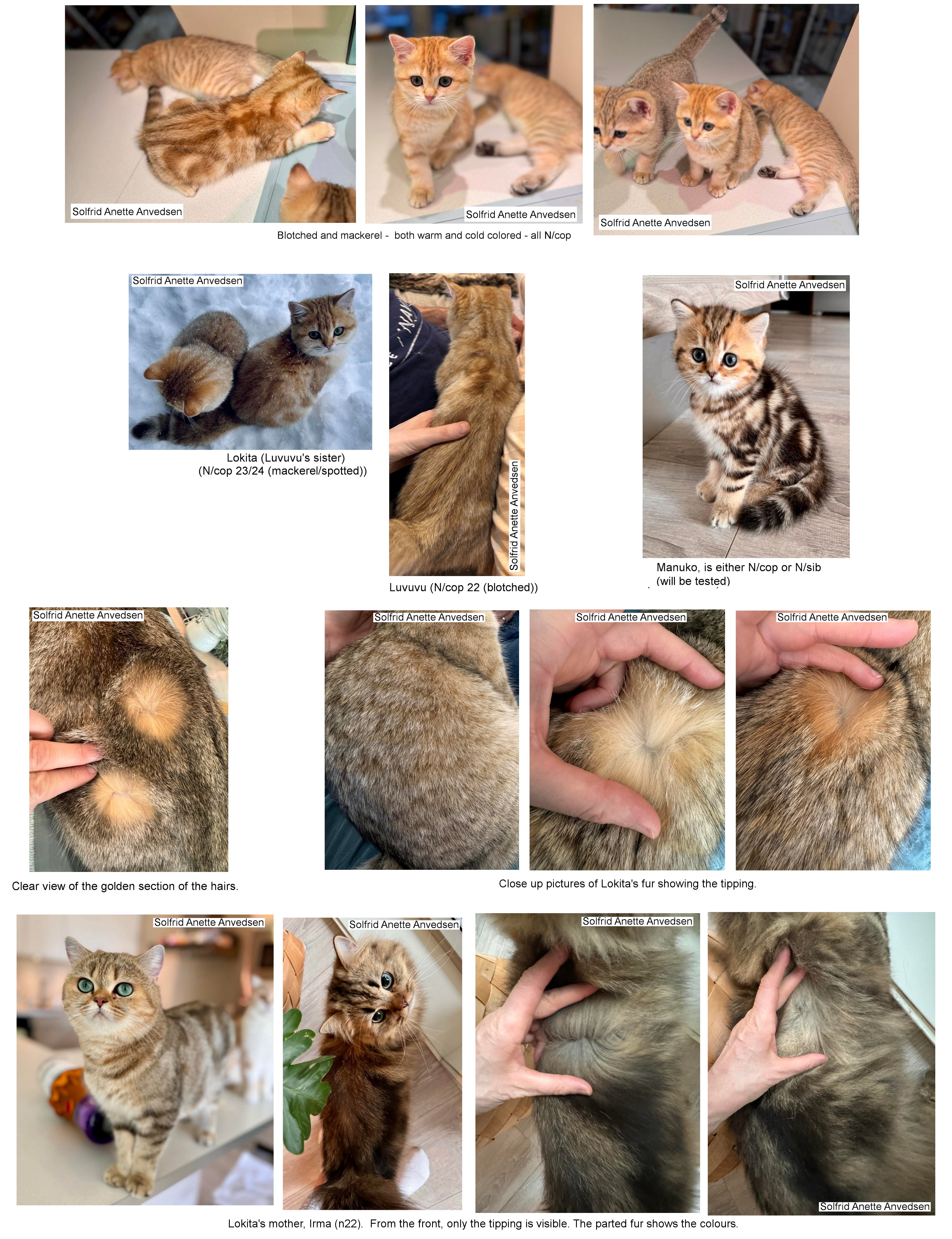
REGISTRY CODES FOR SUNSHINE
In LOOF (French official registry) wbBSH, wbSIB (wbSUN) and wbESIB (wbESUN) are recognised with the EMS symbol u. WCF used u for sunshine Siberians in 2017, and because the wb mutations are all on the CORIN locus, locus CORIN, LOOF decided to keep "u" and add the code of breed to differentiate the different mutations. All CORIN described mutations in British and Siberian are recessive, but Siberians can also have the combinations wbSIB/wbESIB (heterozygous sunshine/extreme sunshine), which is also EMS code "u."
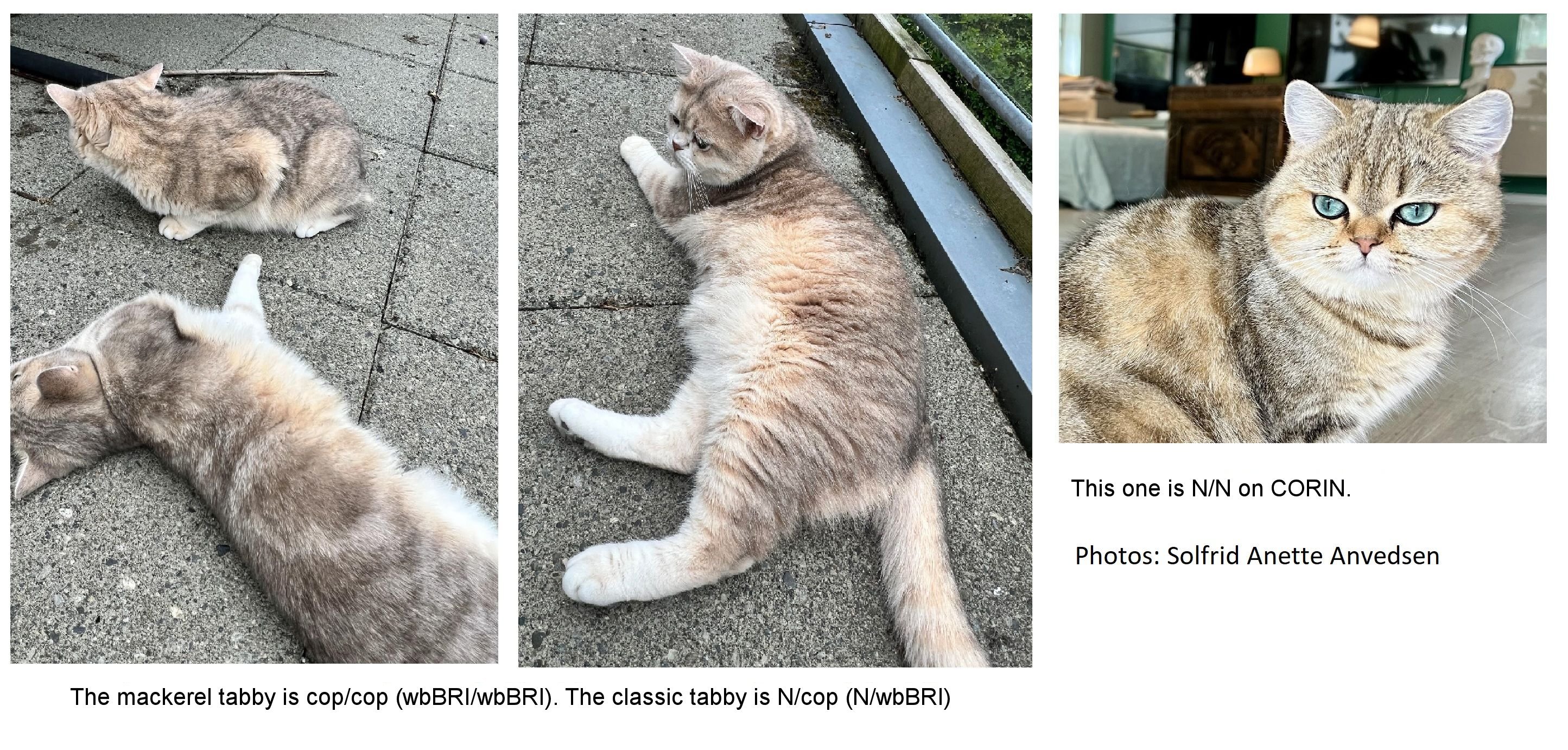

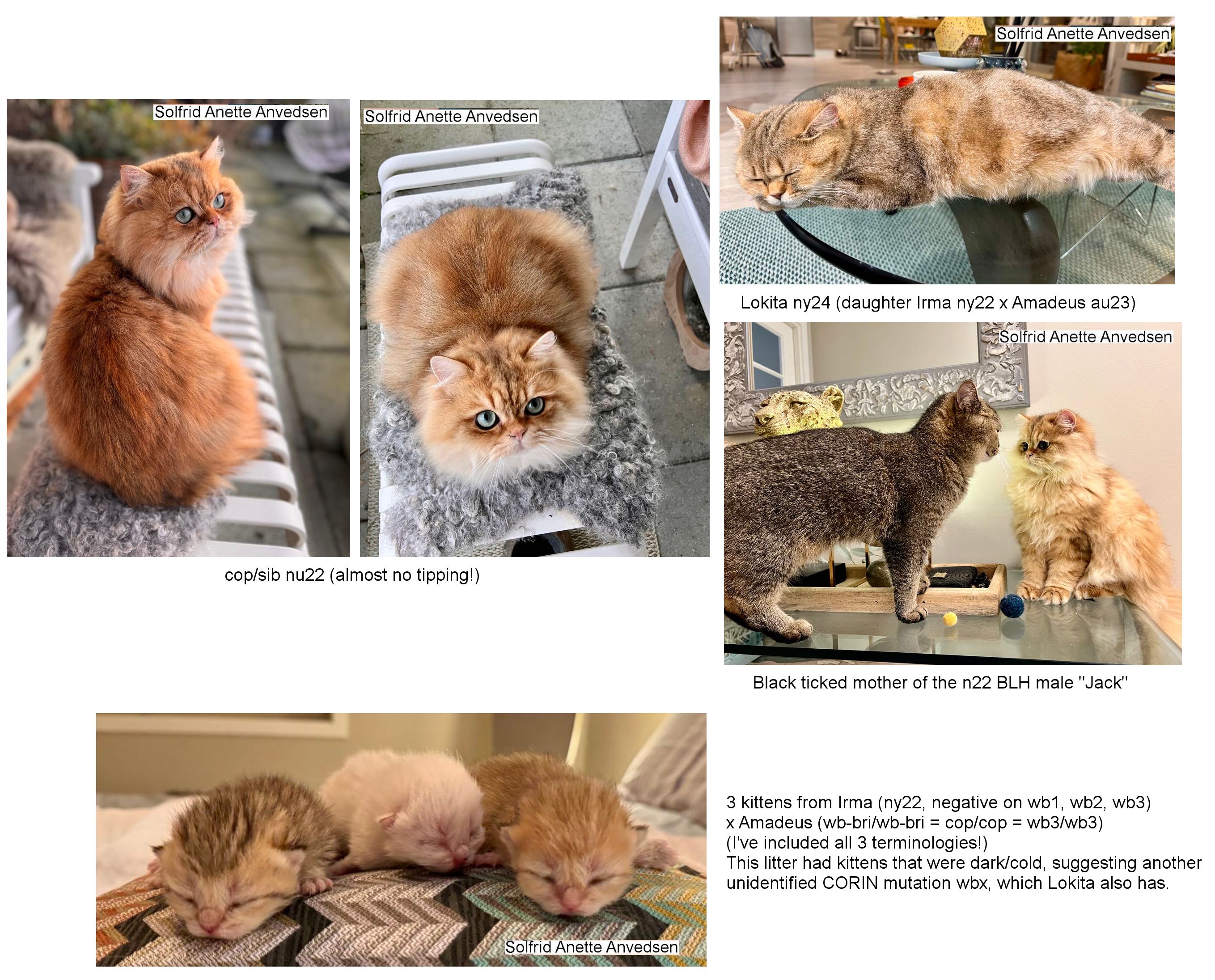
HOW DID THE SIBERIAN CORIN GENE (SUNSHINE) GET INTO THE BRITISH SHORTHAIR/LONGHAIR GENE POOL?
The wbSIB gene was named after the first breed it was identified in. It does not mean that that gene is found only in the Siberian breed. It doesn't mean that someone mixed Siberian cats into the gene pool either, so "sunshine" British SH/LH cats are not "impure". Due to the mixed ancestry of cats back in the early days of the western cat fancy, the gene could have been lurking in the gene pool for centuries, obscured by other genes in the mix. The family tree below shows no Siberian ancestry behind the "sunshine" British SH/LH, but several lines include Persian (or Exotic Shorthair) ancestors. In turn, the Persian cat was developed using longhairs from Turkey and from Russia. Cats are bred for phenotyple - for how close they are to a standard of points for colour and form - and it is only recently that geneticists have started identifying genes behind their colours. So a gene now associated with the Siberian breed would have passed unnoticed, or its effects dismissed as effects caused by polygenes.
Another possibiity is that the "sunshine" mutation occurred spontaneously in the British SH/LH at some point.
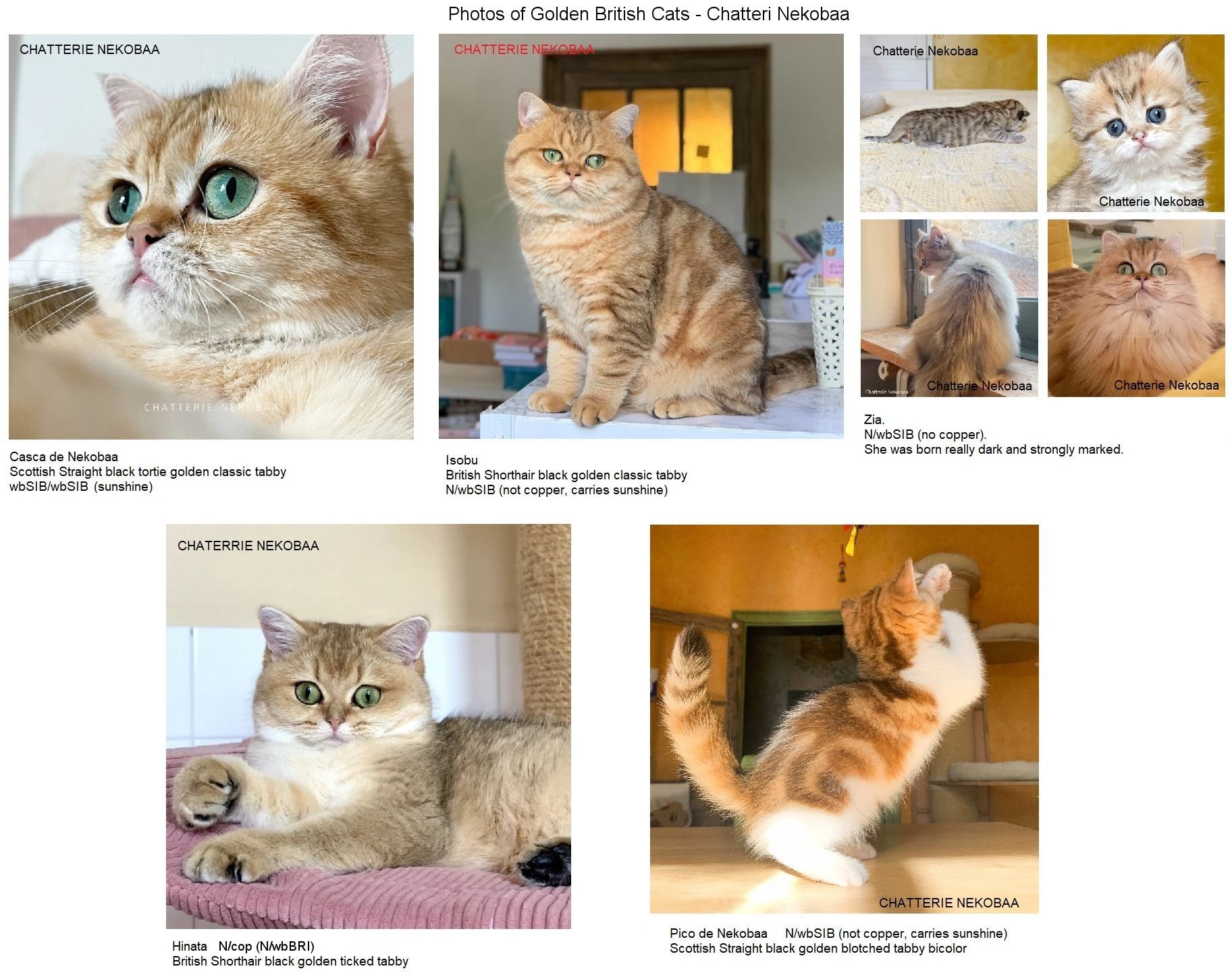
Copper is a desirable colour in Russia and Ukraine and commands a high price. This provoked the question of whether there was a hidden Siberian x British Longhair/Scottish Straight Longhair mating to improve copper. If so, it seems to be unrecorded. For example, Elodie-Elin (Linda Edell Ahlstrom) appears to be copper, but is heterozygous for both genes and there is no record of Siberian ancestry.
Could sunshine have been hidden behind silver British Shorthairs and overlooked as poorly coloured golden. A BSH breeder observed Siberian type golden colours in the BSH in the 1980s and stopped breeding them because they were considered to have a fault. If a BSH/BLH tests negative for the known wbBRI gene then it is worth getting it tested for the wbSIB gene.
Was sunshine lurking in the gene pool of the Persian? Persians were developed from Angoras and Russian Longhairs. Later on, Persians were used to improve the BSH (the BLH is a due to a recessive longhair gene in BSH). Until 1970, golden Persians and BSH were not recognised or registered. Most golden BSH were due to the recessive form of the inhibitor (silver) gene. 30 samples from classic golden Persian tested negative for wbSIB (sunshine) and wbESIB extreme sunshine.
Regarding the possible Persian link, Eleonora Ruggiero sent many DNA samples from classic golden Persian and Exotic breed cats to Marie Abitbol, and none had wbSIB or wbBRI mutations. These samples didn t include any from the late colour change Platinum Persians that are born silver, but end up golden (found in some weANDE lines Australia and NZ).
Click on the very extensive family tree below to read it better!
COPPER AND BRITISH SUNSHINE RESEARCH UPDATE JULY 2023
Marie Abitbol had one sample from a cat strongly suspected to be homozygous I/I and cop/cop (it will be tested for silver soon) and this cat looked white, but there are no white cats in its lineage.
Cats which only carry copper mutation cannot be sunshine (in the same way that cats that carry lilac are not lilac in colour). A bimetallic kitten was found to be n/cop + silver (mother ns11 n/cop, father sunshine cop/cop). ns11 n/cop appears bimetallic; ny11 n/cop has a more golden colour.
It is a matter of what is defined as sunshine phenotype. Marie classed all (cop/cop) and bimetallic cats (N/cop) as sunshine because breeders sent samples of both genotypes under the name sunshine. To help clarify in her results, she referred to cop/cop as pink sunshine and N/cop (bimetallic) as silver sunshine.
Classic golden is a cooler colour than copper, but for many breeders this difference is not obvious. Copper has characteristic cream belly and insides of limbs, cream highlights on the toes and black tail-tip (otherwise the black pigment is virtually eliminated), pink nose without dark border. Sunshine kittens (very pale coats) occurred in litters from copper, golden shaded or ticked parents, but the name sunshine is specific to Siberian cats and is a misnomer in British Shorthairs/Longhairs. British Sunshine ranges from very pale copper ( pink sunshine ) to a shaded silver type sunshine ( silver sunshine ) even though neither parents are silver. Silver sunshine can come from two shaded golden parents (giving the impression of a recessive silver mutation). The gene and mode of transmission had not been identified as at July 2023.
In Siberian cats, the silver is more visible in kittens, but is difficult to see in adults, so it is hard to see which are true cop/cop sunshine and which are N/cop bimetallic.
Marie's British sunshine (copper) research program found:
1) Sunshine British cats with a very light golden tone are silver (probably heterozygous) + copper (homozygous)
2) Sunshine cats with a silver background and traces of golden are silver (probably heterozygous) + copper carrier (heterozygous)
3) Some copper cats (homozygous for copper) and some golden shaded cat that are heterozygous for copper can carry the silver mutation without expressing it
4) Not all copper cats carry silver.
There is some genomic evidences for sunshine = copper + silver which is confirmed by Leslie Lyons researches on silver. Additionally, Marie Abitbol is awaiting the silver-test results that will confirm the results for individual cats being tested for sunshine.
What is still unknown:
1) Why do some copper carriers (heterozygous) + silver appear silver, but others appear sunshine?
2) Why is the silver mutation not visible in some golden shaded and copper cats?
So far, we can explain why sunshine kittens can be born to two non-silver parents or to two silver parents!
I = dominant silver (normal silver - accepted)
i (i+) = classic gold or copper or all other colours except silver and smoke (recessive form of normal silver)
Ir = recessive silver (or is this recessive maybe classic gold?) So far, we don't know if recessive silver exists. It is a hypothesis, not confirmed yet.
The DNA test for silver in China is supposed to test for the mutation. The DNA test from Leslie Lyons tests for two genetic variants that are associated to the mutation (they are close to the mutation on the chromosome, and transmitted together). There is no dominant or recessive silver with this test. Both variants would show as I . Are the cats heterozygous for both silver polygenes (I/Ir) or heterozygous for I/I?
To date we don't know whether polygenes/multiple mutations for silver exist. Chinese and USA DNA tests are testing the same allele.
From Judy Hao & Petgeno, China:
The British Shorthair and British Longhair have inherited many colour genes from Persian Longhairs to improve the conformation or introduce new colours. See also Inhibitor Gene: Platinum" Persians - A Late Colour Change Gene
In China, Arwen, a golden female, and Bear, also golden, produced a silver kitten, Yin Bao. Arwen s breeder reported that Arwen had previously produced 4 silver kittens in her litters. None of the silver offspring have been bred, so there is no data on what they transmit. The golden offspring mated with different tipped/shaded golden female cats were able to produce silver offspring.
Arwen's father, Cosmos, is a golden bred at Infinity Jewel cattery (Russia, St. Petersburg, born March 21, 2017) by Viktoria Podkopaylo. His full name is Infinity Jewel Cosmos Golden. Viktoria Podkopaylo added the adjective "Golden" and declared Cosmos to be black golden shaded based on appearance. The French LOOF called him "ny 11 - probably silver" - registry databases annotated him as "probably silver" to prevent rejected kitten registrations. Cosmos is on many pedigrees around the world of British golden akitas or sunshine, and has a purely golden appearance. He was was sold to to Irina Malyutina (Russia), and Mr. Liang Shang then purchased Cosmos as his main stud cat. Mr. Liang has studied gold, gold and silver for many years and summarized a lot of very valuable information. Cosmos's breeders of Cosmos were confused and upset that Cosmos produced both gold and silver offspring as it meant the authenticity of his pedigree was questioned.
To verify Cosmos's ability to produce silver, Mr Liang he mated him with several shaded golden females from different blood lines. No matter which female cat Cosmos mated with, there were some silver offspring, but these were not simple tipped/shaded silvers. The silver was very obvious in the kittens, but as they grew they developed more golden colours. The outer coat and guard hairs were more silvery, while the soft undercoat was more golden. Because cats shed most of their undercoat when moulting, the gold and silver levels of sunshine individuals varied greatly at different stages of their moult, but in general, as they grew older they became more golden. The breeders called this sunshine, a name borrowed from Siberian cats.
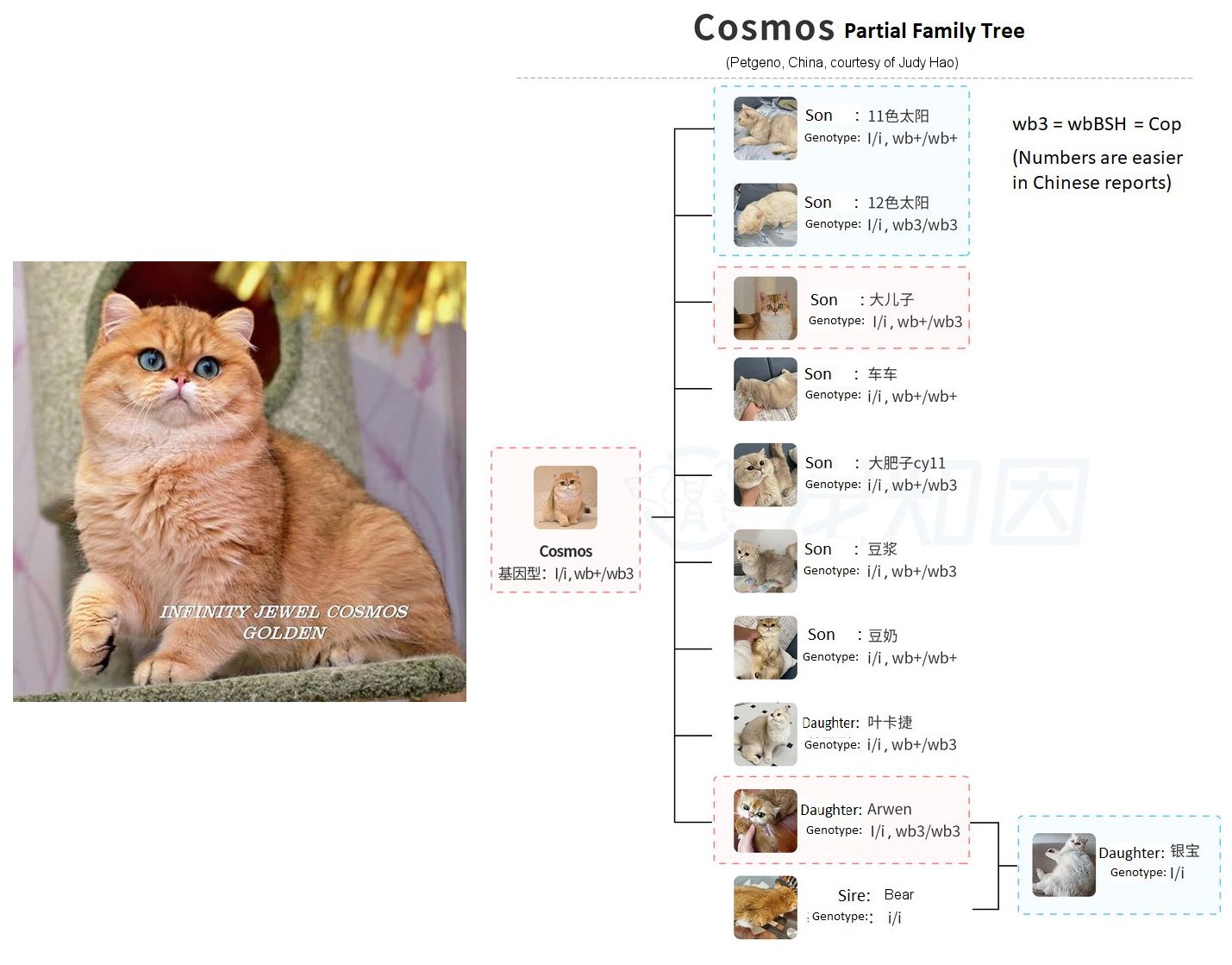
Some of Cosmos's golden descendants, such as Arwen, also produced silver offspring. Although these descendants were golden from birth to adulthood, they produced "sunshine" offspring. Because silver is a dominant gene, something else must be happening. Two non-silver parents should not produce silver offspring.
Could this be a new recessive silver gene that can be carried by non-silver parents? Or could it be a gene at a different locus that prevents the well-known dominant inhibitor gene (silver) from working? Petgeno in China collected samples from all relevant individuals and analysed their silver gene genotypes. All the tipped/shaded golden individuals that were able to produce both gold and silver offspring (e.g. Cosmos, Arwen and the eldest son) had the silver gene. All "sunshine" individuals in the pedigree also had the silver gene. The golden chinchilla/shaded golden individuals that did not produce "sunshine" offspring did not have the silver gene.
PETGENO certified Cosmos to be a British sunshine ( I/i; wb+/wb3 [wb3 = wbBSH]) despite not looking like one. The statement that it is impossible for sunshine descendants to come from two authentic British "goldens" is, therefore, incorrect. Cosmos' current owner said "It is said that Cosmos' foreign breeders were also very confused and distressed about his ability to produce both silver and golden, and the authenticity of his pedigree was often questioned . " i.e. he breeds as a heterozygous silver, not as a golden.
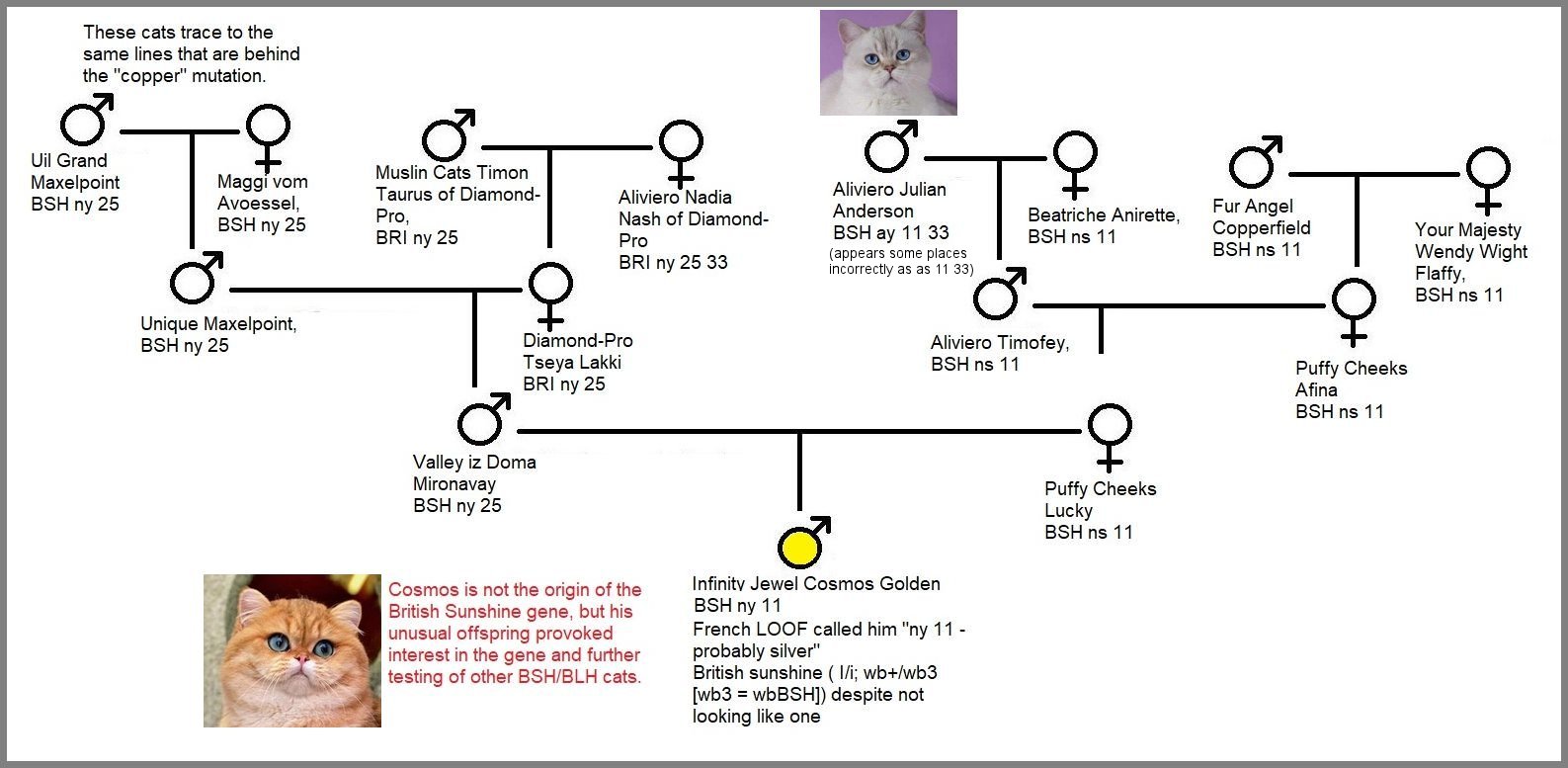
The sunshine colour was caused by the silver mutation, but some other gene interfered with how silver was expressed. That other gene had to be semi-dominant. When heterozygous (one copy) it partially suppressed silver and gave the sunshine colour (Marie Abitbol s silver sunshine ). When homozygous (2 copies) it completely suppressed the silver gene, producing the tipped/shaded golden colour (Marie Abitbol s pink sunshine ). When this other gene was present (1 or 2 copies) but there was no silver gene, the other gene could not be expressed (in the same way that non-agouti silver cats are smokes because there is no yellow band for the silver to act upon).
Breeders wondering whether they have a tipped/shaded silver/golden cat or a sunshine cat can now test for silver. "Sunshine" cannot be simply classed as tipped/shaded silver based on appearance, because those silver-carrying sunshine individuals start off silver but turn gradually golden as they mature. A cat with the new gene that suppresses expression of silver cannot simply be called tipped/shaded silver because its adult colour will look golden so a new name is needed to differentiate them.
Because there are tests for silver, breeders interested in the new "sunshine" colour can test golden-looking cats to see if they also have the silver gene; these cats can produce sunshine offspring. To avoid the sunshine colour they should avoid using cats that have the silver gene.